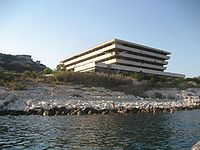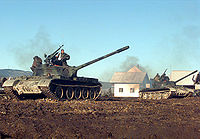- Yugoslav Wars
-
This article is about the military conflicts resulting from the dissolution of Yugoslavia. For an account of the events entailing the destruction of the Yugoslav state, see Breakup of Yugoslavia."War in the Balkans" redirects here. For the 1912–1913 wars in the Balkans, see Balkan Wars.
Yugoslav Wars Part of the Breakup of Yugoslavia 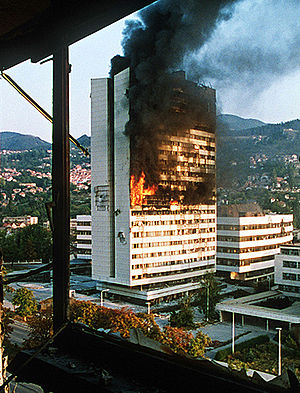
The building of the Parliament of Bosnia and Herzegovina burns after being hit by Serbian tank fire (1992).Date 1991–1995 Location Territory of the former SFR Yugoslavia: Territory outside the SFR Yugoslavia:
Result New countries independent Belligerents 1991–92:
 Slovenia
Slovenia
(1991 only)1991–92:
 Yugoslav People's Army
Yugoslav People's Army
(1991 only)1992–94:  Herzeg-Bosnia
Herzeg-Bosnia
(up to 1994)1992–94: 1992–94:  FR Yugoslavia
FR Yugoslavia
 Republika Srpska
Republika Srpska AP Western Bosnia (1993 on)
AP Western Bosnia (1993 on)1994–95:  Republic of
Republic of
Bosnia and Herzegovina
 NATO
NATO
(bombing operations, 1995)1994–95: Commanders and leaders  Franjo Tuđman
Franjo Tuđman
 Mate Boban
Mate Boban
 Milivoj Petković
Milivoj Petković
 Dario Kordić
Dario Kordić
 Alija Izetbegović
Alija Izetbegović

 Slobodan Milošević
Slobodan Milošević

 Momir Bulatović
Momir Bulatović
 Branko Kostić
Branko Kostić
 Vojislav Šešelj
Vojislav Šešelj
Casualties and losses  20,000+ killed
20,000+ killed
 64,000+ killed
64,000+ killed 32,000+ killed
32,000+ killeda From 1992–1994 the Republic of Bosnia and Herzegovina was at the time representative mainly of the Bosniak (Bosnian Muslim) ethnic group in Bosnia and Herzegovina itself. From 1994–1995, after the Washington Agreement, the state was also representative of the Bosnian Croat ethnic group. Yugoslav Wars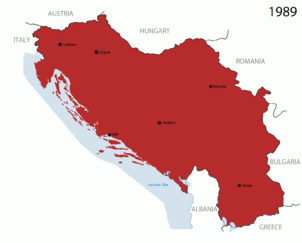 Croatia Croatian Republic of Herzeg-Bosnia Serbia and Montenegro Republic of Srpska Republic of Serbian Krajina Republic of Bosnia and Herzegovina Bosnia and Herzegovina Autonomous Province of Western Bosnia Macedonia Slovenia
Croatia Croatian Republic of Herzeg-Bosnia Serbia and Montenegro Republic of Srpska Republic of Serbian Krajina Republic of Bosnia and Herzegovina Bosnia and Herzegovina Autonomous Province of Western Bosnia Macedonia Slovenia
The Yugoslav Wars were a series of wars, fought throughout the former Yugoslavia between 1991 and 1995. The wars were complex: characterized by bitter ethnic conflicts among the peoples of the former Yugoslavia, mostly between Serbs (and to a lesser extent, Montenegrins) on the one side and Croats and Bosniaks (and to a lesser degree, Slovenes) on the other; but also between Bosniaks and Croats in Bosnia (in addition to a separate conflict fought between rival Bosniak factions in Bosnia). The wars ended in various stages and mostly resulted in full international recognition of new sovereign territories, but with massive economic disruption to the successor states.
Often described as Europe's deadliest conflicts since World War II, the conflicts have become infamous for the war crimes involved, including mass ethnic cleansing.[1] These were the first conflicts since World War II to be formally judged genocidal in character and many key individual participants were subsequently charged with war crimes.[2] The International Criminal Tribunal for the former Yugoslavia (ICTY) was established by the UN to prosecute these crimes.[3]
Although tensions in Yugoslavia had been mounting since the early 1980s, it was 1990 that proved decisive. In the midst of economic hardship, Yugoslavia was facing rising nationalism amongst its various ethnic groups. At the 14th Extraordinary Congress of the League of Communists of Yugoslavia in January 1990, the Serbian-dominated assembly agreed to abolish the single-party system; however, Slobodan Milošević, the head of the Serbian Party branch (League of Communists of Serbia) used his influence to block and vote-down all other proposals from the Croatian and Slovene party delegates. This prompted the Croatian and Slovene delegations to walk out and thus the break-up of the party,[4] a symbolic event representing the end of "brotherhood and unity".
According to International Center for Transitional Justice, the Yugoslav Wars resulted in deaths of 140,000 people.[5] The Humanitarian Law Center writes that in the conflicts in former Yugoslav republics at least 130,000 people lost their lives.[6]
The Yugoslav Wars may be considered to be three separate but related wars:
- War in Slovenia (1991)
- Croatian War of Independence (1991–1995)
- Bosnian War (1992–1995)
Contents
Terminology
The war(s) have alternatively been called:
- "War in the Balkans": largely inappropriate, partly because the war affected not only the Western Balkans but also because certain areas which saw fighting (e.g. most of Slovenia, the Croatian land of Slavonia) are often seen as belonging to Central Europe and not the Balkans.
- The "Balkan War against Milosevic" (stresses the US participation and mission).
- "War in (the former) Yugoslavia"
- "Wars of Yugoslav Secession/Succession"
- "Third Balkan War": a term suggested by British journalist Misha Glenny in the title of his book, alluding to the two previous Balkan Wars fought 1912–1913.[7] In fact, the term has already been applied by contemporary historians to World War I as an allusion that it was a direct sequel of the 1912–1913 Balkan wars.[8]
Background
Main article: Breakup of YugoslaviaBefore World War II, major tensions arose from the first, monarchist Yugoslavia's multi-ethnic make-up and relative political and demographic domination of the Serbs. Fundamental to the tensions were the different concepts of the new state. The Croats envisaged a federal model where they would enjoy greater autonomy than they had as a separate crown land under Austria-Hungary. Under Austria-Hungary, Croats enjoyed autonomy with free hands only in education, law, religion and 45% of taxes.[11] The Serbs tended to view the territories as a just reward for their support of the allies in World War I and the new state as an extension of the Serbian Kingdom.
The Serbs sacrificed their own state (which was in that time a little bit larger than today's Serbia, including much of Kosovo and Macedonia) in order to realize the ideal of a "South Slav state".[citation needed][neutrality is disputed]
Tensions between the two ethnic groups often erupted into open conflict, with the Serb dominated security structure exercising oppression during elections[12] and the assassination in federal parliament of Croat political leaders, including Stjepan Radić, who opposed the Serbian monarch's absolutism. The assassination and human rights abuses were subject of concern for the Human Rights League and precipitated voices of protest from intellectuals, including Albert Einstein.[13] It was in this environment of oppression that the radical insurgent group (later fascist dictatorship), the Ustaše were formed.
During World War II, the country's tensions were exploited by the occupying Axis forces which established a Croat puppet state spanning much of present day Croatia and Bosnia and Herzegovina. The Axis powers installed the Ustasha as the leaders of the "Independent State of Croatia".
The Ustaše resolved that the Serbian minority were a fifth column of Serbian expansionism, and pursued a policy of persecution against the Serbs. The policy dictated that one third of the Serbian minority were to be killed, one third expelled, and one third converted to Catholicism and assimilated as Croats. Conversely, the Chetniks pursued their own campaign of persecution in parts of Bosnia and Herzegovina and Sandžak per the Moljevic plan ("On Our State and Its Borders") and the orders issues by Draža Mihailović which included "[t]he cleansing of all nation understandings and fighting.
Both Croats and Muslims were recruited as soldiers by the SS (primarily in the 13th Waffen Mountain Division).
At the same time, former Royalist General Milan Nedić was installed by the Axis as head of the Serb puppet state and local Serbs were recruited into the Gestapo and the Serbian Volunteer Corps.
Both quislings were confronted and eventually defeated by the communist-led anti-fascist Partisan movement composed of members of all ethnic groups in the area, leading to the formation of the Socialist Federal Republic of Yugoslavia.
The official Yugoslav post-war estimate of victims in Yugoslavia during World War II was 1,704,000. Subsequent data gathering in the 1980s by historians Vladimir Žerjavić and Bogoljub Kočović showed that the actual number of dead was about 1 million. Of that number, 330,000–390,000 ethnic Serbs perished from all causes in Croatia and Bosnia.[14]
Despite the federal structure of the new Yugoslavia, there was still tension between the federalists, primarily Croats and Slovenes who argued for greater autonomy, and unitarists, primarily Serbs. The struggle would occur in cycles of protests for greater individual and national rights (such as the Croatian Spring) and subsequent repression. The 1974 constitution was an attempt to short-circuit this pattern by entrenching the federal model and formalizing national rights.
SFR Yugoslav dissolution wars
In the years leading up to the Yugoslav wars, relations among the republics of the Socialist Federal Republic of Yugoslavia deteriorated. Slovenia and Croatia desired greater autonomy within the Yugoslav confederation, while Serbia sought to strengthen federal authority. As it became clearer that there was no solution agreeable to all parties, Slovenia and Croatia moved toward secession.
By the early 1990s there was no effective authority at the federal level. The Federal Presidency consisted of the representatives of all 6 republics and 2 provinces and JNA (Yugoslav People's Army) and communist leadership was divided along national lines.
The final breakdown occurred at the 14th Congress of the Communist Party when Croat and Slovenian delegates left in protest because the pro-integration majority in the Congress rejected their proposed amendments.
Ten-Day War (1991)
Main article: Ten-Day War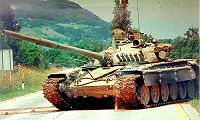 JNA M-84 MBT during first operations in Slovenia.
JNA M-84 MBT during first operations in Slovenia.
The first of these conflicts, known as the Ten-Day War, was initiated by the federal Yugoslav People's Army on 26 June 1991 after the secession of Slovenia from the federation on 25 June 1991.[15][16]
Initially, the federal government ordered the Yugoslav People's Army to secure border crossings in Slovenia. Slovenian police and Slovenian Territorial Defence blockaded barracks and roads, leading to stand-offs and limited skirmishes around the republic. After several dozen casualties, the limited conflict was stopped through negotiation at Brioni on 9 July 1991, when Slovenia and Croatia agreed to a three-month moratorium on secession. The Federal army completely withdrew from Slovenia by 26 October 1991.
Croatian War of Independence (1991–1995)
Main article: Croatian War of IndependenceFighting in this region had begun weeks prior to the Ten-Day War in Slovenia. The Croatian War of Independence began when Serbs in Croatia, who were opposed to Croatian independence, announced their secession from Croatia. This was triggered by a provision in the new Croatian Constitution that replaced an explicit reference to Serbs in Croatia as a "constituent nation" with a generic reference to all other nations, and was interpreted by Serbs as being reclassified as a "national minority".
The JNA had disarmed the Territorial Units of the two northernmost republics prior to the declaration of independence, so the fledgling Croatian state had to form its military from scratch[citation needed]. This was hindered by an arms embargo, imposed by the UN on Yugoslavia.
The Yugoslav People's Army (JNA) was ostensibly ideologically unitarian, but its officer corps was predominantly staffed by Serbs. As a result the JNA opposed Croatian independence and sided with the Croatian Serb rebels. The Croatian Serb rebels were unaffected by the embargo as they had the support of and access to supplies of the JNA.
The border regions faced direct attacks from forces within Serbia and Montenegro, and saw the shelling of UNESCO world heritage site Dubrovnik, where the international press was criticised for focusing on the city's architectural heritage, instead of reporting the destruction of Vukovar, a pivotal battle involving many civilian deaths.[17]
Bosnian War (1992–1995)
Main article: Bosnian WarIn March 1991, the Karađorđevo agreement took place between Franjo Tuđman and Slobodan Milošević. The two presidents tried to reach an agreement on the disintegration process of Yugoslavia, but their main concern was Bosnia, or more precisely its partition.
Meanwhile, control over central Croatia was seized by Croatian Serb forces in conjunction with the JNA Corps from Bosnia and Herzegovina, under the leadership of Ratko Mladić.[18]
These attacks were marked by the killings of captured soldiers and heavy civilian casualties (Ovčara; Škabrnja), and were the subject of war crimes indictments by the ICTY for elements of the Serb political and military leadership.
In January 1992, the Vance-Owen peace plan proclaimed UN controlled (UNPA) zones for Serbs in territory claimed by Serbian rebels as the Republic of Serbian Krajina and brought an end to major military operations, though sporadic artillery attacks on Croatian cities and occasional intrusions of Croatian forces into UNPA zones continued until 1995.
In 1992, conflict engulfed Bosnia and Herzegovina. The war was predominantly a territorial conflict between local Bosniaks and Croats backed by Zagreb, and Serbs backed by the Yugoslav People's Army and Serbia.
The Yugoslav armed forces had disintegrated into a largely Serb-dominated military force. Opposed to the Bosnian-majority led government's agenda for independence, and along with other armed nationalist Serb militant forces, the JNA attempted to prevent Bosnian citizens from voting in the 1992 referendum on independence.[19] This did not succeed in persuading people not to vote and instead the intimidating atmosphere combined with a Serb boycott of the vote resulted in a resounding 99% vote in support for independence.[20]
On 19 June 1992, the war in Bosnia broke out. The conflict, typified by the siege of Sarajevo and Srebrenica, was by far the bloodiest and most widely covered of the Yugoslav wars. Bosnia's Serb faction led by ultra-nationalist Radovan Karadžić promised independence for all Serb areas of Bosnia from the majority-Bosniak government of Bosnia.
To link the disjointed parts of territories populated by Serbs and areas claimed by Serbs, Karadzic pursued an agenda of systematic ethnic cleansing primarily against Bosnians through genocide and forced removal of Bosniak populations.[21]
The Central Intelligence Agency (CIA) in the United States reported in April 1995 that 90 percent of all the atrocities in the Yugoslav wars up to that point had been committed by Serb militants.[22] Most of these atrocities occurred in Bosnia.
In 1994 the US brokered peace between Croatian forces and the Bosnian Army of the Republic of Bosnia and Herzegovina. After the successful Flash and Storm operations, the Croatian Army and the combined Bosnian and Croat forces of Bosnia and Herzegovina, conducted an operation codenamed Operation Maestral to push back Bosnian Serb military gains.
Together with NATO air strikes on the Bosnian Serbs, the successes on the ground put pressure on the Serbs to come to the negotiating table. The fighting in Croatia ended in mid-1995, after Operation Flash and Operation Storm. At the end of these operations, Croatia had managed to reclaim all of its territory except the UNPA Sector East bordering Serbia, however most of the Serbian population in these areas had become refugees, and these operations have led to war crimes indictments by the ICTY against elements of the Croat military leadership. The areas uncaptured by the Croations forces in "Sector East" came under UN administration (UNTAES), and were reintegrated to Croatia in 1998.
Pressure was put on all sides to stick to the cease-fire and finally negotiate an end to the war in Bosnia.
The war ended with the signing of the Dayton Agreement on the 14 December 1995, with the formation of Republika Srpska as an entity within Bosnia and Herzegovina being the resolution for Bosnian Serb demands.
War crimes
War rape
Main article: Rape in the Bosnian WarWar rape occurred as a matter of official orders as part of ethnic cleansing, to displace the targeted ethnic group.[23]
During the Bosnian War, "rape camps" aimed at the birth of a new generation of Serb children, were reportedly used. The purpose of these camps was to impregnate the Bosnian and Croatian women. Because of the patrilineal make-up of the society, in which children inherit their father's ethnicity, this was used a method of ethnic cleansing. In the camps, women were kept in confinement until the late stage of their pregnancy.
According to the Women's Group Tresnjevka more than 35,000 women and children were held in such Serb-run "rape camps".[24][25][26] Dragoljub Kunarac, Radomir Kovač, and Zoran Vuković were convicted for rape, torture, and enslavement committed during the Foča massacres.[27]
The evidence of the magnitude of rape in Bosnia and Herzegovina prompted the International Criminal Tribunal for the former Yugoslavia (ICTY) to deal openly with these abuses.[28] Reports of sexual violence during the Bosnian War (1992–1995) and Kosovo War (1996–1999) perpetrated by the Serbian regular and irregular forces have been described as "especially alarming".[29] Since the entry of the NATO-led Kosovo Force, rapes of Albanian, Roma and Serbian women by Serbs and members of the Kosovo Liberation Army, have been documented.[30]
Others have estimated that during the Bosnian War between 20,000 and 50,000 women, mainly Muslim, were raped.[31][32] A Commission of Experts appointed in October 1992 by the United Nations concluded that
Rape has been reported to have been committed by all sides to the conflict. However, the largest number of reported victims have been Bosnian Muslims, and the largest number of alleged perpetrators have been Bosnian Serbs. There are few reports of rape and sexual assault between members of the same ethnic group.[33]
Although men also became victim of sexual violence, war rape was disproportionately directed against women who were (gang) raped in the streets, in their homes and/or in front of family members.
War rape in the Yugoslav Wars has often been characterized as genocide. Rape perpetrated by Serb forces served to destroy cultural and social ties of the victims and their communities.[34] Serbian policies urged soldiers to rape Bosnian women until they became pregnant as an attempt towards ethnic cleansing. Serbian soldiers hoped to force Bosnian women to carry Serbian children through repeated rape.[35] Often Bosnian women were held in captivity for an extended period of time and only released slightly before the birth of a child conceived of rape.
The systematic rape of Bosnian women may have carried further reaching repercussions than the initial displacement of rape victims. Stress caused by the trauma of rape coupled with the lack of access to reproductive health care often experienced by displaced peoples lead to serious health risks for victimized women.[36]
A brief timeline of the Yugoslav Wars including events leading to conflict
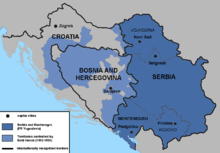 The War Crimes Tribunal accused Slobodan Milošević of "attempting to create a Greater Serbia"', a Serbian state encompassing the Serb-populated areas of Croatia and Bosnia, and achieved by forcibly removing non-Serbs from large geographical areas through the commission of the crimes.[37]
The War Crimes Tribunal accused Slobodan Milošević of "attempting to create a Greater Serbia"', a Serbian state encompassing the Serb-populated areas of Croatia and Bosnia, and achieved by forcibly removing non-Serbs from large geographical areas through the commission of the crimes.[37] Main articles: Timeline of Yugoslavian breakup and Timeline of the Yugoslav wars
Main articles: Timeline of Yugoslavian breakup and Timeline of the Yugoslav wars1968
- Students in Kosovo demand greater rights for the Albanian minority during the worldwide May 1968 protests.
1971
- Demonstrations in Croatia, known as the Croatian spring, are condemned by the communist government. Many participants were later convicted as nationalists, including Stipe Mesić and Franjo Tuđman. Government crisis follows.
1974
- A new SFRY constitution is proclaimed, granting more power to federal units, and more power to autonomous provinces Kosovo and Vojvodina of Serbia, giving them all a single vote in all relevant decisions in the federal government, which is now headed by the joint Presidency with a rotating President. Muslims were recognized as a constituent nation of Yugoslavia, becoming the primary ethnic group of Bosnia and Herzegovina and Kosovo.
1980
- Yugoslav leader Josip Broz Tito dies.
1981
- Economic crisis in Yugoslavia has begun. Albanian students demonstrate in Kosovo, demanding federal unit status.
1986-1989
- The controversial Memorandum of the Serbian Academy of Sciences and Arts claims Serbia has a weak position in Yugoslavia.
- Slobodan Milošević rises to power in Serbia, promising to defend and promote the interests of Serbs across Yugoslavia and challenge politicians who were deemed to be repressing the interests of Serbs. Antibureaucratic revolution demonstrations overthrow Communist party leadership and bring pro-Milošević governments to power in Vojvodina, Kosovo and Montenegro. The other republics' leaderships oppose Milošević's coups
1988-1989
1989
- Kosovar Albanians continued to demonstrate throughout 1989 after Milosevic adopted amendments to the Serbian Constitution that took away Kosovo’s control over the police force, civil defense, economic, civil and criminal courts, social and education policy. The amendments also effectively prohibited the use of Albanian as an official language in Kosovo and forbade the sale of property to Albanians. This was followed by the closure of the Albanian language newspaper, and the Kosovo Academy of Sciences. Some 80,000 Kosovo Albanians were fired from state employment.
1990
- The League of Communists of Yugoslavia dissolves on republican and ethnic lines at its 14th Congress with Slovene and Croatian delegations leaving amid claims that Milošević is usurping power.
- The first democratic elections are held in socialist Yugoslavia. Nationalist parties win the majority in almost all republics.
- Constitutional changes in Serbia revoke some of the powers granted to Kosovo and Vojvodina, effectively giving Serbia 3 out of 8 votes in the federal council. Along with allied Montenegro, this gives extreme power to the Serbian elite. With these votes, Serbian representatives attempt to institute martial law to stop democratic changes – their attempt fails as Bosnia's representative (an ethnic Serb) votes against in the crucial last vote.
- In Serbian capital of Belgrade, student protests against Milošević end with police crackdown: one student is killed.
- Albanian miners go on strike in Kosovo, which Milošević ends with a police and army crackdown.
- Croatian Serbs start a rebellion against the newly elected Croatian government led by Franjo Tuđman, severing land ties between Dalmatia and remainder of Croatia.
1991
- Slovenia and Croatia declare independence in June, Macedonia in September. War in Slovenia lasts ten days.
- The Yugoslav army leaves Slovenia, but supports rebel Serb forces in Croatia. The Croatian War of Independence begins in Croatia. Serb areas in Croatia declare independence, but are recognized only by Belgrade.
- Cities of Vukovar, Dubrovnik and Osijek are devastated by bombardments and shelling. A flood of refugees from the war zones and ethnic cleansing overwhelm entire Croatia. Countries of Europe are slow in accepting refugees.
- In Croatia, more than 400 000 Croats and other non-Serbs were either removed out of their homes by the Serb forces or fled the violence.
- Macedonia declares independence in September.
1992
- Vance peace plan signed, creating four UNPA zones for Serbs and ending large scale fighting in Croatia.
- Bosnia declares independence. Bosnian war begins.
- Federal Republic of Yugoslavia proclaimed, consisting of Serbia and Montenegro, the only two remaining republics.
- United Nations impose sanctions against FR Yugoslavia and accepts Slovenia, Croatia and Bosnia as members. FR Yugoslavia claims being sole legal heir to SFRY, which is disputed by other republics. UN envoys agree that Yugoslavia had 'dissolved into constituent republics'.
- Approx. 600,000 non-Serbian refugees.
- Bosniak-Croat conflict begins in Bosnia.
1993
- Fighting begins in the Bihać region between Bosnian Government forces loyal to Alija Izetbegović, and Bosniaks loyal to Fikret Abdić who is supported by Serbs.
- Sanctions and in F.R. Yugoslavia, now isolated, create hyperinflation of 3.6 million percent a year of the Yugoslav dinar; this had never been known previously. The inflation exceeds that experienced in the Great Depression of 1929.
- The Stari Most (The Old Bridge) in Mostar, built in 1566, was destroyed by Bosnian Croat forces. It was rebuilt in 2003.
1994
- Peace treaty between Bosniaks and Croats arbitrated by the United States, Federation of Bosnia and Herzegovina formed.
- F.R. Yugoslavia stabilizes economy structure with Economic Implementation Framework.
1995
- Srebrenica massacre reported, 8,372 Bosniaks killed by Serb forces.
- Croatia launches Oluja, reclaiming all UNPA zones except Eastern Slavonia, and resulting in exodus of 150,000–200,000 Serbs from the zones. War in Croatia ends.
- NATO launches a series of air strikes on Bosnian Serb artillery and other military targets.
- Dayton Agreement signed in Paris. War in Bosnia and Herzegovina ends. Aftermath of war is over 100,000 killed and missing and 2.5 million people internally displaced among the former republics. Serb defeat in Croatia and West Bosnia allows Croatian and Bosniak refugees to return to their homes, but many refugees of all nationalities are still displaced today.
- After signing the Dayton Agreement, Yugoslavia is granted with looser sanctions, still affecting much of its economy (trade, tourism, industrial production and exports of final products), but allowing for its citizens to exit Yugoslavia, for a limited time.
See also
- Arbitration Commission of the Peace Conference on the former Yugoslavia
- Balkanization
- Breakup of Yugoslavia
- Timeline of Yugoslav breakup
- Serbia in the Yugoslav Wars
References
- ^ Ethnic cleansing in the Balkans ... - Google Books
- ^ Bosnia Genocide | United Human Rights Council
- ^ www.icty.org/
- ^ "Milosevic's Yugoslavia: Communism Crumbles". BBC News. http://news.bbc.co.uk/hi/english/static/in_depth/europe/2000/milosevic_yugoslavia/communism.stm.
- ^ "Transitional Justice in the Former Yugoslavia". 1 January 2009. http://ictj.org/publication/transitional-justice-former-yugoslavia. Retrieved 8 September 2009.
- ^ "About us – Humanitarian Law Center". Humanitarian Law Center. http://www.hlc-rdc.org/stranice/Linkovi-modula/About-us.en.html. Retrieved 17 November 2010.
- ^ The Fall of Yugoslavia: Amazon.co.uk: Misha Glenny: Books
- ^ "A history of Eastern Europe: crisis and change" by Robert Bideleux, Ian Jeffries, 2nd edition, 2007, ISBN 0415366275, p. 123
- ^ Google books
- ^ Google scholar
- ^ Constitution of Union between Croatia-Slavonia and Hungary.
- ^ Elections, TIME Magazine, 23 February 1925.
- ^ Appeal to the international league of human rights, Albert Einstein/Heinrich Mann.
- ^ Staff. Jasenovac concentration camp, Jasenovac, Croatia, Yugoslavia. On the website of the United States Holocaust Memorial Museum.
- ^ Race, Helena (2005) (in Slovene). "Dan prej" – 26. junij 1991: diplomsko delo ["A Day Before" – 26 June 1991: Diploma Thesis]. Faculty of Social Sciences, University of Ljubljana. http://dk.fdv.uni-lj.si/dela/Race-Helena.PDF. Retrieved 3 February 2011.
- ^ Prunk, Janko (2001). "Path to Slovene State". Public Relations and Media Office, Government of the Republic of Slovenia. http://www.slovenija2001.gov.si/10years/path/. Retrieved 3 February 2011.
- ^ Joseph Pearson, 'Dubrovnik’s Artistic Patrimony, and its Role in War Reporting (1991)' in European History Quarterly, Vol. 40, No. 2, 197–216 (2010), http://ehq.sagepub.com/cgi/content/abstract/40/2/197
- ^ "Profile: Ratko Mladic". The British Broadcasting Corporation. 31 July 2008. http://news.bbc.co.uk/1/hi/1423551.stm. Retrieved 18 November 2008.
- ^ Mestrovic, Stjepan G. 1996. Genocide After Emotion: The post emotional Balkan War. London and New York: Routledge. p. 36.
- ^ Mestrovic, p. 36.
- ^ Mestrovic, Stjepan G. 1996. Genocide After Emotion: The post emotional Balkan War. London and New York: Routledge. p. 7.
- ^ Mestrovic, p. 8.
- ^ de Brouwer, Anne-Marie (2005). Supranational Criminal Prosecution of Sexual Violence. Intersentia. p. 10. ISBN 9050955339. http://books.google.com/books?id=JhY8ROsA39kC&pg=PA10&lpg=PA10.
- ^ de Brouwer, Anne-Marie (2005). Supranational Criminal Prosecution of Sexual Violence. pp. 9–10. ISBN 9050955339. http://books.google.com/books?id=JhY8ROsA39kC&pg=PA9&lpg=PA9.
- ^ new Internationalist issue 244, June 1993. Rape: Weapon of War by Angela Robson.
- ^ Netherlands Institute for War Documentation Part 1 Chapter 9
- ^ Human Rights News Bosnia: Landmark Verdicts for Rape, Torture, and Sexual Enslavement: Criminal Tribunal Convicts Bosnian Serbs for Crimes Against Humanity 02/22/01.
- ^ Simons, Marlise (June 1996). "For first time, Court Defines Rape as War Crime". The New York Times. http://www.nytimes.com/specials/bosnia/context/0628warcrimes-tribunal.html.
- ^ de Brouwer, Anne-Marie (2005). Supranational Criminal Prosecution of Sexual Violence. Intersentia. p. 9. ISBN 9050955339. http://books.google.com/books?id=JhY8ROsA39kC&pg=PA9&lpg=PA9.
- ^ de Brouwer, Anne-Marie (2005). Supranational Criminal Prosecution of Sexual Violence. Intersentia. p. 11. ISBN 9050955339. http://books.google.co.uk/books?id=JhY8ROsA39kC&dq=war+rape+in+ancient+times&source=gbs_summary_s&cad=0.
- ^ "Sexual and Gender-Based Violence in Conflict: A Framework for Prevention and Response". UN Office for the Coordination of Humanitarian Affairs. 2008. http://ochaonline.un.org/News/InFocus/SexualandGenderBasedViolence/AFrameworkforPreventionandResponse/tabid/4751/language/en-US/Default.aspx. Retrieved 30 June 2009.
- ^ "Film award forces Serbs to face spectre of Bosnias rape babies". The Independent (UK). 20 February 2006. http://www.independent.co.uk/arts-entertainment/films/news/film-award-forces-serbs-to-face-spectre-of-bosnias-rape-babies-526028.html. Retrieved 26 June 2009.
- ^ United Nations Commission on Breaches of Geneva Law in Former Yugoslavia
- ^ Card, Claudia (1996). "Rape as a Weapon of War". Hypatia 11 (4): 5–18. ISSN 08875367. http://www.jstor.org.ezproxy1.lib.asu.edu/stable/3810388. Retrieved 10 September 2010.
- ^ Allen, Beverly (1996). Rape Warfare : The Hidden Genocide in Bosnia-Herzegovina and Croatia. University of Minnesota Press.
- ^ McGinn, Therese (2000-12). "Reproductive Health of War-Affected Populations: What Do We Know?". International Family Planning Perspectives 26 (4): 174–180. ISSN 01903187. http://www.jstor.org.ezproxy1.lib.asu.edu/stable/2648255. Retrieved 5 September 2010.
- ^ Decision of the ICTY Appeals Chamber; 18 April 2002; Reasons for the Decision on Prosecution Interlocutory Appeal from Refusal to Order Joinder; Paragraph 8
External links
- Bora Radović: Jugoslovenski ratovi 1991–1999 i neke od njihovih društvenih posledica. (Serbian)
- Information and links on the Third Balkan War (1991–2001)
- Wiebes, Cees. Intelligence and the War in Bosnia 1992–1995, Publisher: Lit Verlag, 2003
- http://srebrenica.brightside.nl/srebrenica/
- Dr. R. Craig Nation. "War in the Balkans 1991–2002."
- "Yugoslavia: the outworn structure" (CIA) Report from November 1970
- Operation Storm
- Yugoslav wars at the Open Directory Project
- Strategic Studies Institute, 2002, ISBN 1-58487-134-2
Timeline of Yugoslav statehood Timeline Prior to 1918 Creation
1918 – 1941World War II
1938 – 1945Socialist Yugoslavia
1943 – 1992Breakup & Yugoslav Wars
1990 –Slovenia territories controlled by Austria-Hungary
(1867 – 1918)
Included Bay of Kotor
See also:
Kingdom of Croatia-Slavonia
(1868 – 1918)
Kingdom of Dalmatia
(1815 – 1918)
Condominium of BIH
(1878 – 1918)Kingdom of Serbs, Croats and Slovenes
(1918 – 1929)
↓ renamed ↓
Kingdom of Yugoslavia
(1929 – 1943)
See also:
State of Slovenes, Croats and Serbs
(1918)
Banat, Bačka and Baranja (1918-1919)
Free State of Fiume
(Free 1920 – 1924;
Italy 1924 – 1947)annexed by Fascist Italy and Nazi Germany
(1941 – 1943/1945)
Prekmurje annexed by HungaryDemocratic Federal Yugoslavia
(DFY, 1943 – 1946)
↓ renamed ↓
Federal People's Republic of Yugoslavia
(FPRY, 1946 – 1963)
↓ renamed ↓
Socialist Federal Republic of Yugoslavia
(SFRY, 1963 – 1992)
Constituent federal subjects to the rightSR Slovenia
(1944 – 1991)Republic of Slovenia
(since 1991; see Ten-Day War)Dalmatia Independent State of Croatia
(1941 – 1945)
puppet of Nazi Germany, parts annexed by Fascist Italy
Međimurje and Baranja annexed by HungarySR Croatia
(1943 – 1991)Republic of Croatia
(since 1991; see Croatian War of Independence)
See also:
SAO Kninska Krajina (1990) → SAO Krajina (1990 – 1991)
SAO Western Slavonia (1990 – 1991)
SAO Eastern Slavonia, Baranja and Western Syrmia (1990 – 1991)
↳ Republic of Serbian Krajina ↲ (1990 – 1995)Slavonia Croatia Bosnia SR Bosnia and Herzegovina
(1943 – 1992)Bosnia and Herzegovina
(since 1992; see Bosnian War); Consists of:
Federation of Bosnia and Herzegovina (since 1995)
Republika Srpska (since 1995)
Brčko District (since 2000)
See also: Republic of Bosnia and Herzegovina, Croatian Republic of Herzeg-Bosnia
SAO Bosanska Krajina, SAO North-Eastern Bosnia, SAO Romanija, SAO Herzegovina (1991 – 1992)
↳ Serbian Republic of Bosnia and Herzegovina ↲ (1992 – 1995)Herzegovina Vojvodina Autonomous Banat (formally part of Nedić's Serbia)
Bačka annexed by Hungary (1941 – 1944)
Syrmia annexed by Independent State of Croatia (1941 – 1944)SR Serbia
(1943 – 1990)
Included APs:
SAP Vojvodina &
SAP KosovoFederal Republic of Yugoslavia
(1992 – 2003)
↓ renamed ↓
State Union of Serbia and Montenegro
(2003 – 2006)
Consisted of until 2006:
Republic of Serbia (1990)
Republic of Montenegro (1992)
See also:
Republic of Kosova
(1990 – 2000)Republic of Serbia
(2006 – 2008)
Included APs:
Vojvodina &
Kosovo and Metohija
(under UN administration)Republic of Serbia
(since 2006)
Includes AP VojvodinaSerbia Kingdom of Serbia
(1882 – 1918)Nedić's Serbia
(1941 – 1944)
puppet of Nazi Germany
See also: Republic of UžiceKosovo Kingdom of Serbia
(1912 – 1918)mostly annexed by Albania
(1941 – 1944)
along with western Macedonia and south-eastern MontenegroRepublic of Kosovo
(since 2008)
Declared unilateral independence, which is since then only partially recognisedMetohija Kingdom of Montenegro
(1910 – 1918)
Metohija controlled by Austria-Hungary
(1915 – 1918)Montenegro Protectorate annexed by Fascist Italy (1941 – 1943) and Nazi Germany
(1943 – 1944)
Smaller part annexed by Independent State of Croatia (1941 – 1944)SR Montenegro
(1943 – 1992)Montenegro
(since 2006)Macedonia Kingdom of Serbia
(1912 – 1918)annexed by Kingdom of Bulgaria
(1941 – 1944)SR Macedonia
(1944 – 1991)Republic of Macedonia
(since 1991)Armed conflicts in Europe following the end of the Cold War Yugoslavia Ten-Day War (1991) · Croatian War of Independence (1991-1995) · Bosnian War (1992-1995) · Albania-Yugoslav border incident (1999)
Transnistria Albania / Albanians Rebellion in Albania (1997) · Kosovo War (1998-1999) · Albania-Yugoslav border incident (1999) · Insurgency in the Preševo Valley (1999-2001) · Insurgency in the Republic of Macedonia (2001) · 2011 Kosovo–Serbia border clashes
North Caucasus South Caucasus Nagorno-Karabakh Nagorno-Karabakh War (1994) · Mardakert skirmishes (2008) · Nagorno-Karabakh skirmish (2010) · Mardakert skirmishes (2010)
Categories:- Yugoslav Wars
- Wars involving the Balkans
- Yugoslavia
- History of Yugoslavia
- Conflicts in 1991
- Conflicts in 1992
- Conflicts in 1993
- Conflicts in 1994
- Conflicts in 1995
Wikimedia Foundation. 2010.


